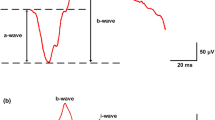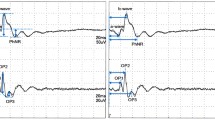Abstract
Purpose
We have monitored retinal function in patients treated for retinoblastoma (primarily, but not exclusively by intra-arterial chemotherapy infusion) by electroretinography (ERG) recordings for the past 7 years. We here present data from 599 ERG studies of 108 patients, in which a complete ERG protocol including both photopic and scotopic recordings was performed, in justification of our frequent practice of reporting primarily 30-Hz photopic flicker amplitude data.
Methods
Patients referred for treatment of retinoblastoma underwent ERG recordings during examination under anesthesia whenever possible: at baseline and following most treatment sessions. Correlations were calculated for the complete datasets between the four primary amplitude response parameters: photopic single flash b-wave, photopic 30-Hz flicker peak-to-trough, scotopic rod-isolating b-wave, and scotopic maximal flash b-wave.
Results
Using our adaptation of the International Society for Clinical Electrophysiology of Vision-recommended standard ERG protocol, ERG responses of eyes of patients with untreated retinoblastoma or following traditional or intra-arterial treatment for retinoblastoma show very high correlations between 30-Hz flicker amplitude responses and three other standard photopic and scotopic ERG response amplitudes. Reductions in ERG amplitudes seen in these eyes following treatment show no significant difference between retinal dysfunction estimated using rod- or cone-dominated responses.
Conclusion
These observations support the use of photopic response amplitudes (especially in response to 30-Hz flicker) as the primary ERG outcome measure in studies of treated and untreated eyes with retinoblastoma when more complete ERG protocols may be impractical.







Similar content being viewed by others
References
Friedman DN, Sklar CA, Oeffinger KC, Kernan NA, Khakoo Y, Marr BP, Wolden SL, Abramson DH, Dunkel IJ (2013) Long-term medical outcomes in survivors of extra-ocular retinoblastoma: the Memorial Sloan-Kettering Cancer Center (MSKCC) experience. Pediatr Blood Cancer 60(4):694–699
Abramson DH, Dunkel IJ, Brodie SE, Kim JW, Gobin YP (2008) A phase I/II study of direct intraarterial (ophthalmic artery) chemotherapy with melphalan for intraocular retinoblastoma initial results. Ophthalmology 115(8):1398–1404
Abramson DH, Francis JH, Dunkel IJ, Marr BP, Brodie SE, Gobin YP (2013) Ophthalmic artery chemosurgery for retinoblastoma prevents new intraocular tumors. Ophthalmology 120(3):560–565
Brodie SE, Munier FL, Francis JH, Marr B, Gobin YP, Abramson DH (2013) Persistence of retinal function after intravitreal melphalan injection for retinoblastoma. Doc Ophthalmol Adv Ophthalmol 126(1):79–84
Brodie SE, Gobin YP, Dunkel IJ, Kim JW, Abramson DH (2009) Persistence of retinal function after selective ophthalmic artery chemotherapy infusion for retinoblastoma. Doc Ophthalmol Adv Ophthalmol 119(1):13–22
Cameron AM, Mahroo OA, Lamb TD (2006) Dark adaptation of human rod bipolar cells measured from the b-wave of the scotopic electroretinogram. J Phys 575(Pt 2):507–526
Mahroo OA, Lamb TD (2004) Recovery of the human photopic electroretinogram after bleaching exposures: estimation of pigment regeneration kinetics. J Phys 554(Pt 2):417–437
Marmor MF, Holder GE, Seeliger MW, Yamamoto S, International Society for Clinical Electrophysiology of V (2004) Standard for clinical electroretinography (2004 update). Doc Ophthalmol Adv Ophthalmol 108(2):107–114
Sachidanandam R, Krishnakumar S, Gopal L, O’Brien JM, Khetan V, Sen P (2013) Full-field electroretinography under general anesthesia in retinoblastoma. Doc Ophthalmol 126(2):149–157
Brodie SE, Desiderio DP, Abramson DH (2009) Comparison of ERG baselines under anesthesia with bis analysis of eeg activity. Association for research in vision and ophthalmology, abstract 4514
Brodie SE, Naidu EM, Goncalves J (1992) Combined amplitude and phase criteria for evaluation of macular electroretinograms. Ophthalmology 99(4):522–530
Victor JD, Mast J (1991) A new statistic for steady-state evoked potentials. Electroencephalogr Clin Neurophysiol 78(5):378–388
Acknowledgments
We thank Rosa Chu and the team at the MSKCC retinoblastoma clinic for help with patient care and efficient acquisition of ERG data.
Conflict of interest
None.
Author information
Authors and Affiliations
Corresponding author
Rights and permissions
About this article
Cite this article
Liu, C.Y., Jonna, G., Francis, J.H. et al. Non-selectivity of ERG reductions in eyes treated for retinoblastoma. Doc Ophthalmol 128, 13–23 (2014). https://doi.org/10.1007/s10633-013-9416-8
Received:
Accepted:
Published:
Issue Date:
DOI: https://doi.org/10.1007/s10633-013-9416-8




